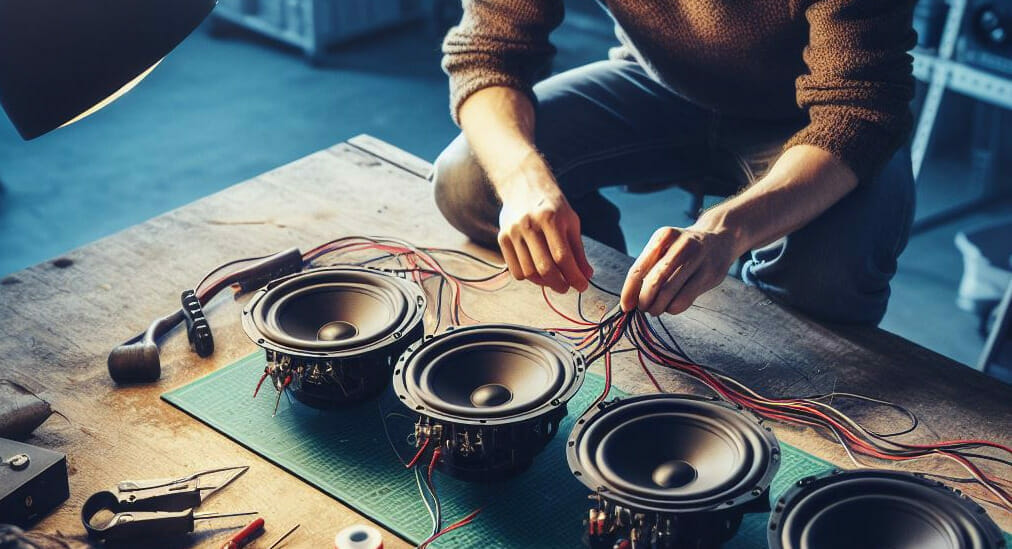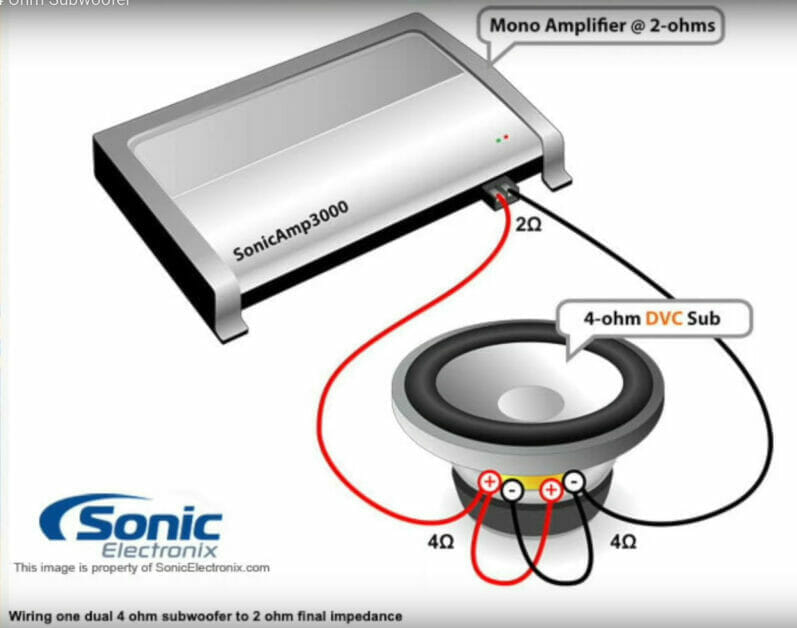How to Wire Parallel Speakers (4 Situations)

This article shows how to wire speakers in parallel with each other.
The procedure is simple, but I’ll show how to do it in 4 different situations:
- Wiring a dual subwoofer in parallel
- Wiring 2 speakers in parallel to a single-channel
- Wiring pairs of speakers in parallel to each of multiple channels
- Wiring multiple (more than 2) speakers per channel
Summary of the general procedure: When wiring speakers in parallel, we join the same terminals on each together, i.e., the positive ones together and, separately, the negative ones together. The amplifier then connects with any parallel-connected speakers or pairs of terminals.
I’ve also explained the impact of wiring speakers in parallel.
Getting Started
Requirements
You usually need some or all of the following to wire speakers in parallel (and to an amplifier):
- Main Items: speakers (or dual subwoofer), amplifier
- Tools: wire stripper, wire crimper
- Materials: ring terminals, electrical tape
- Instruments: ohmmeter (or multimeter set to ohms)
- Wires: speaker wires (see below)
The Wires for Wiring Speakers
The wires typically used for wiring speakers, whether parallel or series, are 18-, 16-, or 14-gauge.
Generally, an 18-gauge wire is good for up to 50 watts at 25 feet. Use a 16-gauge wire if the wattage or distance is greater or a 14-gauge wire if the output wire is weak.
Before connecting the wires to the speakers, you must strip the insulation off their ends using a wire stripper. About half an inch should be sufficient.
Procedures
First, I will show how to wire a dual subwoofer and then 2 speakers in parallel. You can easily extend the system to add more speakers in parallel once you know the basic method.
Wiring a Dual Subwoofer in Parallel
Follow the steps below to wire a dual subwoofer in parallel.
Step 1: Connect the Corresponding Terminals
To wire a dual subwoofer in parallel, connect the corresponding (same polarity) terminals together in any order.
- Connect the 2 positive terminals.
- Connect the 2 negative terminals.
That’s all you need to do to wire a dual subwoofer in parallel. But you will also need to connect an amplifier to make it useful.
Step 2: Connect the Amplifier
Connect the amplifier to any pair of terminals on the subwoofer.
It doesn’t matter which one you connect to because they are connected in parallel. But usually, you would connect to the nearest one for convenience.
Connect the same terminals together:
- Connect the amplifier’s positive terminal to one of the subwoofer’s positive terminals.
- Connect the amplifier’s negative terminal to one of the subwoofer’s negative terminals.
Wiring Diagram
Below is the wiring diagram for a dual subwoofer connected in parallel to an amplifier.

Wiring Two Speakers in Parallel
Wiring 2 or more speakers in parallel is similar to wiring a dual subwoofer, except the pairs of terminals are on separate speakers.
Step 1: Connect the Corresponding Terminals
To wire 2 speakers in parallel, connect the corresponding (same polarity) terminals together in any order.
- Connect one speaker’s positive terminal to the other speaker’s positive terminal.
- Connect one speaker’s negative terminal to the other speaker’s negative terminal.
That’s all you need to do to wire 2 speakers in parallel. But you will also need to connect an amplifier to make it useful.
Step 2: Connect the Amplifier
Connect the amplifier to any one of the speakers.
It doesn’t matter which one you connect to because they are all connected in parallel. But usually, you would connect to the nearest one for convenience and the best performance.
Connect the same terminals together:
- Connect the amplifier’s positive terminal to one speaker’s positive terminal.
- Connect the amplifier’s negative terminal to the speaker’s negative terminal.
Wiring Diagram
Below is the wiring diagram for a pair of speakers connected in parallel to an amplifier.

Wiring Pairs of Speakers in Parallel
We will suppose you have 8 speakers to connect in parallel to explain the procedure.
Wiring Pairs of Speakers
When wiring pairs of speakers to a channel on the amplifier, the procedure is the same as described above, except that you connect each pair to each channel.
The diagram below shows 8 speakers in parallel, where each pair connects to one channel. The positive (+) wire is red, and the negative (-) wire is black.

Wiring Multiple Speakers Per Channel
When wiring more than 2 speakers to a single channel or multiple speakers to a single-channel amplifier, add the ones in the same pattern. Follow these general steps:
Step 1: Strip the Wires
Strip approximately half an inch of the insulation off the ends of all the speaker wires using a wire stripper.
Step 2: Attach the Wires to the First Speaker
Insert the positive speaker wire from one amplifier channel to the first speaker’s positive terminal and the corresponding negative wire to its negative terminal. The first speaker is usually the one nearest to the amplifier.
Step 3: Connect the Next Speaker
Connect the same (positive to positive and negative to negative) terminals of the first speaker to the second one.
Repeat the above for each subsequent speaker until they are connected in parallel. Repeat also for each additional channel on the amplifier, but try to have an equal number of speakers per channel.
Wiring Diagram
Below is the wiring diagram for connecting multiple (4) speakers parallel to the 2 amplifier channels.

The Impact of Wiring Speakers in Parallel
Wiring speakers in parallel reduces the amplifier’s load, improves efficiency, and increases the power output.
The total impedance should be less than the individual impedance. For example, wiring 2 4-ohm speakers should result in a total impedance of around 2 ohms. The lower impedance increases the power output.
For these reasons, users prefer a parallel setup over a series one. So, it’s recommended to wire speakers in parallel unless you have a lot and need to minimize the wiring.
FAQs
Alright, Let’s Jump Into Some Commonly Asked Questions!
Why wire speakers in parallel?
When you wire speakers in parallel, you’re decreasing the total impedance, which, in simple terms, allows more power from the amplifier. This can result in a louder, more efficient system, especially if your amp can handle the reduced impedance!
How does impedance work with parallel wiring?
When speakers are wired in parallel, the impedance halves. So, two 4-ohm speakers wired in parallel will give an impedance of about 2 ohms. Remember: the more speakers you add, the lower the total impedance.
Is there a risk of damaging my amp with parallel wiring?
If the impedance drops too low for the amplifier to handle safely, it might damage the amp or speakers. Always check the manufacturer’s specifications for your amp and speakers before proceeding.
What’s the difference between parallel and series wiring?
In a nutshell, when speakers are wired in parallel, the impedance decreases. In series, it increases. So, two 4-ohm speakers wired in series would have a total impedance of 8 ohms.
Why use a wire stripper?
Safety and efficiency! By using a wire stripper, you’re ensuring that you get a clean, precise cut without risking damage to the wire itself. This ensures a solid connection and optimal performance.
Does the wire gauge matter?
Absolutely! The wire gauge can impact the efficiency and performance of your speaker setup. It’s important to choose the right gauge for your system’s power and the distance between your components.
Can I wire some speakers in parallel and others in series?
Yes, you can! It’s called a series-parallel setup. However, it requires careful planning to ensure you’re not overloading your amplifier or creating imbalances in your sound system.
Should I always opt for parallel wiring?
While parallel wiring has benefits, it’s not always the best choice. It depends on your specific needs, your system’s design, and your equipment’s specifications. Always assess and choose the method that best suits your situation.
Alright, folks, there you have it! If you’re diving into speaker wiring, always double-check everything, stay safe, and, most importantly, have fun with your audio projects! Keep those tunes pumping!
References
Video References:
Provo Beast Audio Installation
